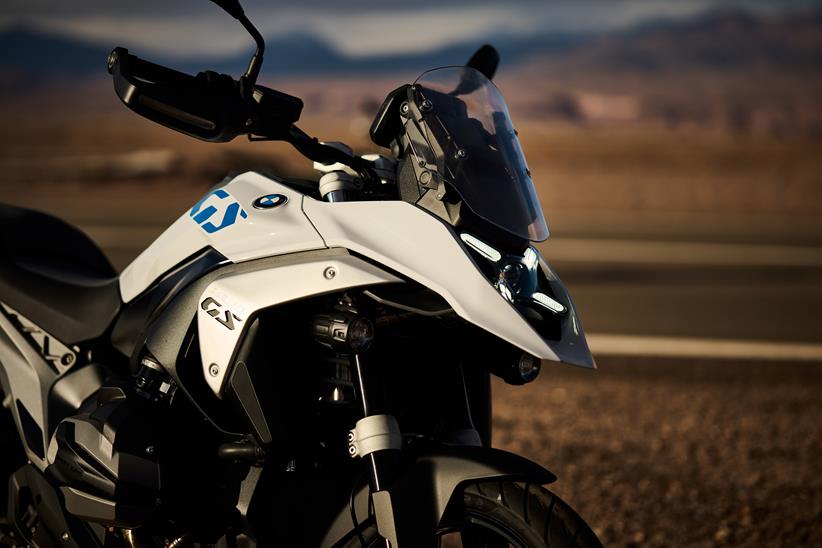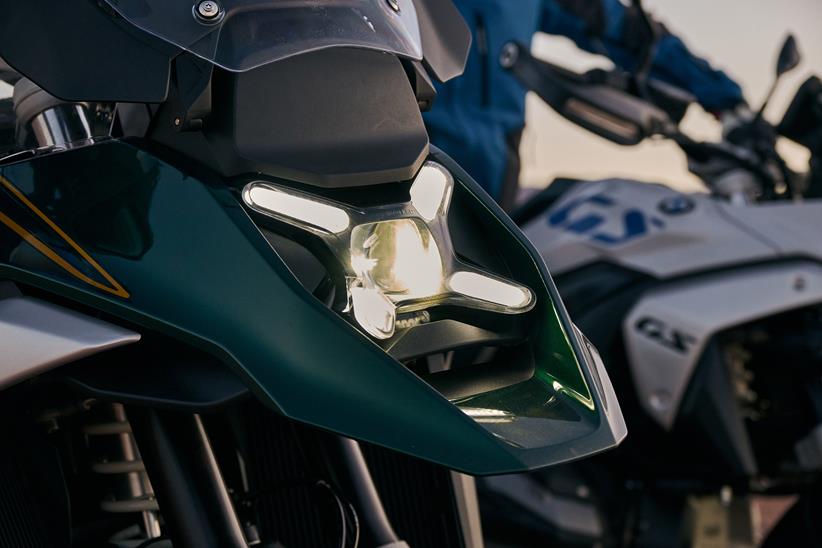A century in the making: BMW’s all-new R1300GS is nothing short of a total transformation for one of the planet’s biggest-selling bikes
Exactly 100 years to the day since launching their very first boxer twin, BMW pulled the covers off an all-new R1300GS. With a completely new engine and frame, ground-breaking technology, and a dramatically different look, it’s the biggest ever overhaul for one of motorcycling’s most popular models.
The R1300GS’s reveal came precisely a century since BMW debuted their R32 at the Berlin Motor Show back on September 28, 1923. The anniversary highlighted how far things have moved on since that original air-cooled 494cc boxer wowed crowds with its 8.5bhp.
By contrast, the new GS packs BMW’s most potent flat twin yet, boasting 143.5bhp and 110lb.ft of torque from its 1300cc capacity. It’s not simply an updated version of their current 1254cc motor, but a total clean-sheet creation with a much more oversquare design, thanks to a larger bore (up from 102.5mm to 106.5mm) and a shorter stroke (down from 76mm to 73mm). It’s more compact too, with its gearbox relocated beneath the engine, and a weight saving across the powertrain of 6.5kg.
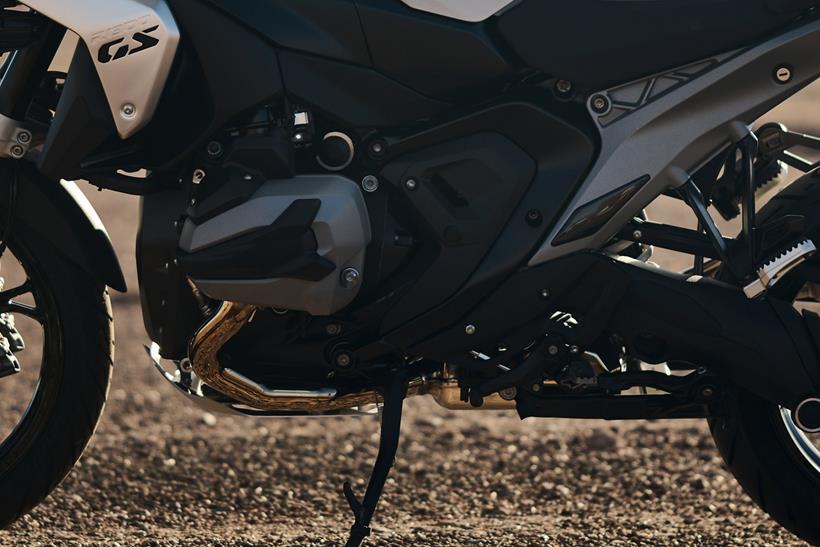
The diet is even more impressive when you look at the bike as a whole. With a kerb weight of 237kg the R1300GS is a full 12kg lighter than the existing R1250GS, thanks in no small part to a new frame and chassis. Out goes the steel tubing, and in comes a brand-new shell-style frame made from sheet metal, with a die-cast aluminium rear subframe that’s substantially shorter than before.
Even the familiar Telelever and Paralever suspension systems have been thoroughly overhauled to be lighter, stiffer and promise more precise steering feel and feedback.
The technology on offer is a generation ahead, too. The R1300GS can be specified with BMW’s new Dynamic Suspension Adjustment (DSA), which takes electronic suspension to another level of versatility by being able to automatically alter not just the damping and preload of both front and rear shocks while you ride, but also stiffen or soften the spring rate. And on top of that, the new GS can be equipped with a new adaptive vehicle height control system which drops the GS’s seat height from 850mm to just 820mm as the bike slows or stops.

Radar sensors are fitted to the front and rear of the GS for the first time, offering smarter and safer mile-munching thanks to a new optional system BMW call Riding Assistant. This includes active cruise control, a new front collision warning system, and a lane-change warning which uses the rear radar to monitor blind spots.
And it won’t have escaped your attention that the GS has been comprehensively – and somewhat controversially – restyled. Gone is the asymmetric headlight design that has become synonymous with the BMW GS family since 1999’s R1150GS, and in comes a starkly different, X-shaped LED unit.
Here the central circle serves as both high and low beam, while the four straight strips pointing out from it are daytime running lights. The headlight can be upgraded to include a cornering function, where the light beam points into a turn as the bike leans into a corner.
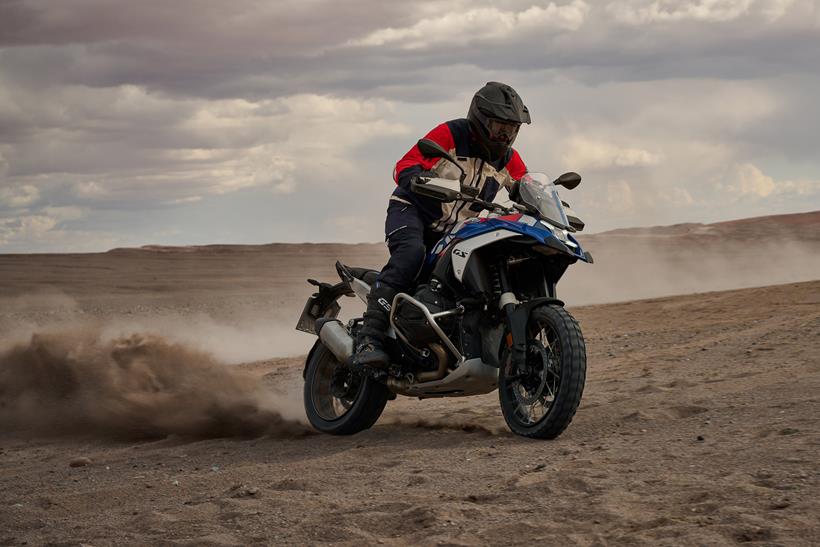
Other new extras include: an electric screen; a range of seat options with different heights, adjustable tilt angles and heating elements; and a complete new range of luggage for global adventures.
However, even on the TE model many of the flagship features will come at an additional cost, including the radar assistance (£760), adaptive height control (£490) and a comfort package (£480). But riders who are interested won’t be kept waiting – the R1300GS is expected to arrive in UK dealers as soon as next month.
BMW’s design boss discusses the radically different look of the new GS
The biggest talking point following the R1300GS’s reveal wasn’t its new motor, frame or technology, but its radical new styling. BMW Motorrad’s head of design, Edgar Heinrich, explains what went into the latest GS…
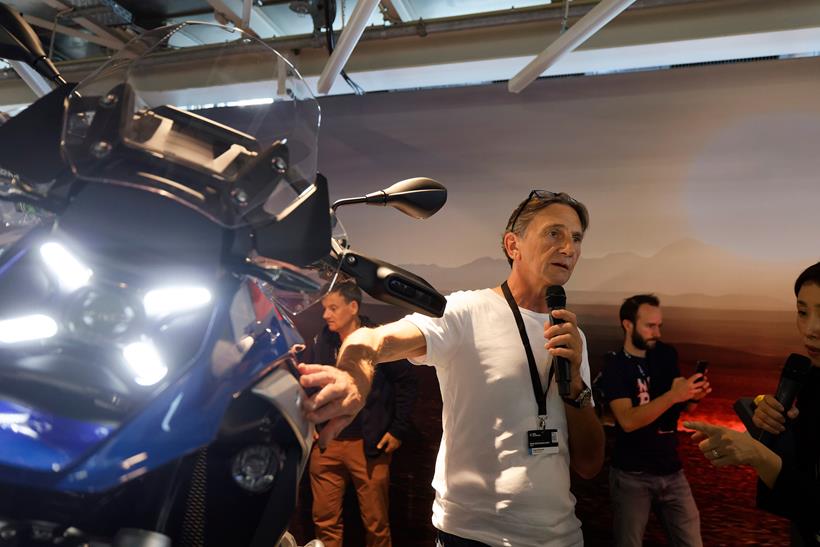
“For you this is a brand-new bike; for me it’s four or five years old! If you go back to when we started on development, we wanted to design a more modern bike, we wanted to gain back the pace in the GS segment. That was the big target. We wanted more power, but also less weight.
“Designers think about what we call first, second and third read. The first read is the proportion, the basic flyline of the bike. It’s a typical GS proportion, but it’s more dynamic, more athletic, more lightweight. It looks much lighter, much smaller than the predecessor. That was very important. The line from the seat up to the tank is more inclined than the old bike, so it gives much more of an off-road feeling.
“Coming to the second read, what we call a formal language. We try to keep all the typical GS icons, but for homologation reasons we can’t do an asymmetric headlight anymore. So the new headlight is a non-typical BMW headlight. It took years for people to get used to our asymmetrical headlight… now everybody loves it!

“When we did asymmetric headlights it was for a technical reason. You had a high beam and a low beam, and there was no need to be symmetric. Here we have an LED Matrix light, so with one lens you can make a high beam, make a low beam, make it turn into a corner as you lean. It was important to find something unique, and new, and fresh, and also very emotional.
“And coming to the third read, the detailing. You see the overall appearance is very clean – it doesn’t have a cluttered look. It’s simple. The bike seems to be easily accessible.”
BMW R1300GS in detail
- All-new frame: Main ‘shell’ frame is now made from sheet steel, rather than tubular, and constructed as a mix of forged and bent sections welded together. BMW say it’s lighter, stiffer and better for packaging. New cast aluminium subframe is both lighter and shorter than the 1250’s tubular steel item.
- Motoring on: New big-bore, short-stroke design boosts the boxer’s capacity to exactly 300cc. Larger valves and a higher 13.3:1 compression ratio help raise peak power to 143bhp at 7750rpm, with peak torque of 110lb.ft at 6500rpm. Redline remains 9000rpm, so it’s no revvier. Retains ShiftCam, which alters intake valve timing and lift.
- All-seeing eye: With the Riding Assistant option (£760) the R1300GS features several radar-based riding aids. These include active cruise control, forward collision warning, and lane-change warning. The front radar sits above the new headlight, while the rear-facing unit sits between the indicators.
- Springing up: Optional DSA electronic suspension offers something unique on road bikes: the ability to switch between two spring rates in real time as you’re riding. Riders seeking extra low-speed confidence can also spec their GS with adaptive vehicle height (£490), which drops the seat by 30mm as you slow to a stop.
BMW R1300GS arrives! More powerful, compact, and lighter adventurer aims for the 2024 top spot
First published 28 September 2023 by Phil West
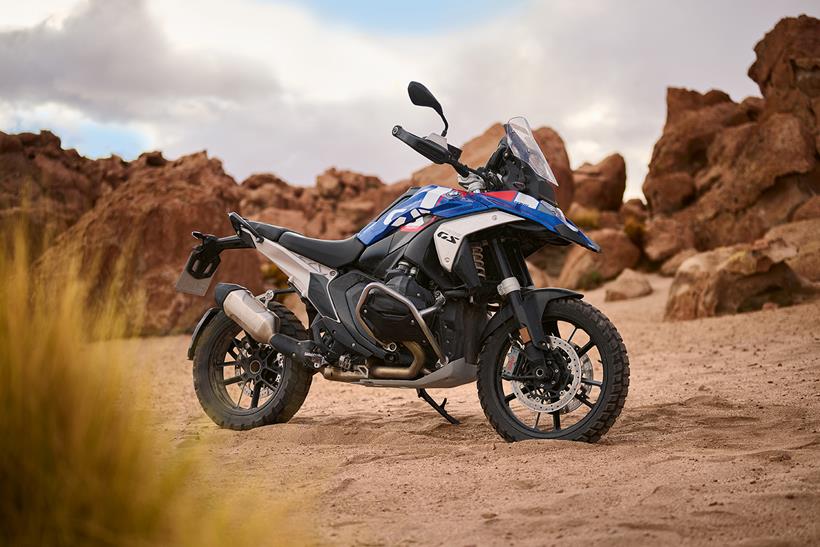
BMW have officially unveiled the all-new R1300GS adventure bike, which takes over from the best-selling BMW R1250GS and aims to be the new benchmark in the go-anywhere class.
Starting at £15,990 and climbing to £18,465 for the TE version, the new GS is powered by a new 1300cc engine producing a claimed 143.5bhp – making it by far the most powerful boxer twin BMW has ever produced.
Add to this an impressive weight saving of 12kg, plus sharper, more compact looks and a slew of sophisticated technology, and it could well take the class crown in 2024.
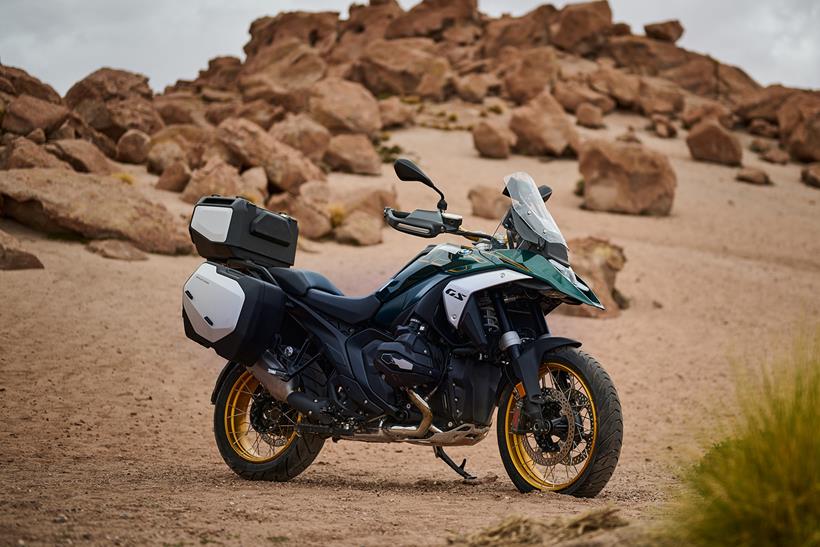
“With the new BMW R1300GS we will once again take the competition by surprise,” Head of Water-cooled Boxer models, Thilo Fuchs said. “It is defined by an even broader spread of product substance, while the reduction in complexity and vehicle weight, combined with focused equipment, enable the essence of the boxer GS to be showcased even more strikingly.”
He continued: “With a new engine, outstanding handling and impressive ride qualities, it will set the pace both on and off the road.”
BMW R1300GS engine explored
At its heart is a virtually all-new boxer engine that’s not only more powerful and torquier than before but lighter and more compact, too.
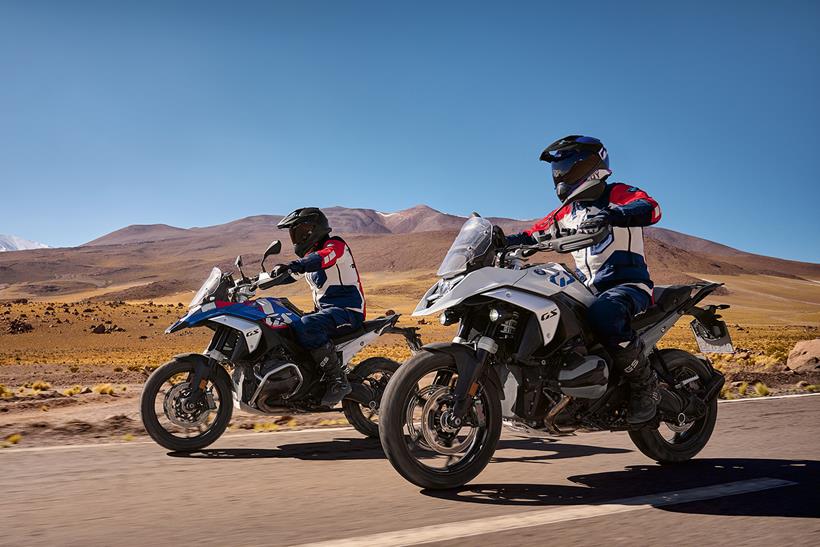
Although its predecessor’s combined air/liquid cooling system is retained, a larger bore but shorter stroke (for higher revs) combines to give a bigger capacity of 1300cc – 46cc more than the outgoing R1250GS.
This, combined with a four-valve, DOHC layout with bigger valves, updated ‘ShiftCam’ variable valve timing system and raised compression of 13.3:1 (from 12.5:1) results in a claimed peak power figure of 145bhp (up from the 1250’s 136bhp) at an unchanged 7750rpm.
Meanwhile, maximum torque sits at a claimed 110lbft at 6500rpm, up from 105.5lbft at 6250rpm. BMW also claims that the new engine’s fuel consumption is almost unchanged – hitting a suggested 49mpg in standard trim, enough for a theoretical 204.8 miles between fill ups.
Elsewhere, the new 1300cc engine is also far lighter and more compact. The gearbox is now underneath rather than behind the engine, reducing overall length and thus weight by 3.9kgs. In addition, the shaft drive unit has also been completely redesigned, further slicing away 2.6kg.
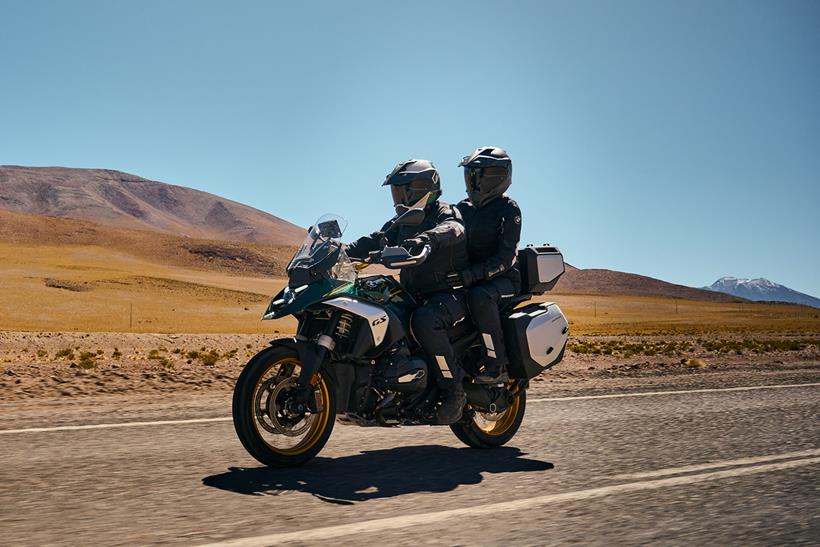
New chassis for 2024
As you might expect, the frame has also been almost completely revised – this time with the emphasis on reducing weight, size, and complexity.
BMW say they wanted to reverse the apparent trend of adventure bikes getting ever bigger and more complex and claim to have achieved that with the help of a new sheet metal ‘shell’ frame for compact packaging, along with a die-cast aluminium rear sub-frame.
Suspension meanwhile, is taken care of by an updated ‘EVO Telelever’ system at the front and ‘EVO Paralever’ at the rear, both of which are claimed to be more rigid and responsive. While the brakes have been uprated with newly developed radial four-piston calipers.
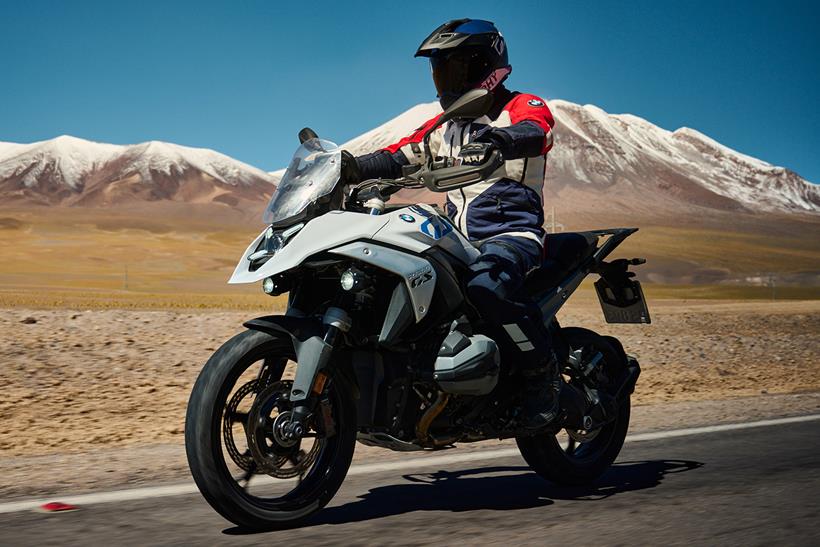
New looks for the R1300GS
Naturally, the new R1300GS’s styling is all-new too, and significantly leaner and more aggressive. The focus is the new ‘Matrix’ full LED headlight with ‘X’ motif, indicators are neatly integrated into the handguards and the overall look is lighter and sharper while still retaining, BMW claims, traditional GS features such as its ‘beak’ and silver side panels.
Standard electronics now comprise four switchable riding modes (up from three) and there’s a new front radar controlled active cruise control, which also informs ‘Front Collision Warning’ and ‘Lane Change Warning’ systems. The dash remains a 6.5in TFT with familiar BMW scrolling wheel switchgear.
Plenty of BMW extras
Optional add-ons include the Dynamic Suspension Adjustment (DSA) – a new system that can change its effective spring rate in milliseconds, ride height alteration, cornering lights, sports suspension and three wheel packages. Four variants will be offered initially: standard, Triple Black, GS Trophy and Option 719 Tramuntana along with four accessory packs plus BMW’s usual array of individual accessory options.







